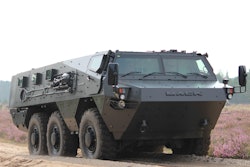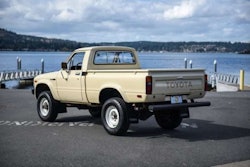As Mack demonstrated early on in World War I, trucks play a critical role in both business and combat.
Typically, controversy often follows trucks slated for warfare, especially in today’s tight-knit international economy.
In late 2015, Toyota found itself on the defensive when the U.S. Treasury Department asked how so many of its Hilux pickups could end up in the hands of Islamic terrorists.
Toyota made it clear that while it had contracts and procedures in place to help prevent its trucks from becoming militarized, it could not ultimately stop enemies of the U.S. and its allies from using its vehicles in combat.
Now China is employing the same defense after its trucks were seen carrying missiles in a recent parade in North Korea honoring the nation’s founder, Kim II Sung, according to the Associated Press.
China reports that it’s been following international trade sanctions against North Korea and that the trucks sold to the Communist nation had been intended for civilian—not military use, a sanction requirement.
The trucks were identified in photos by a Sinotruk logo. Sinotruk’s parent company is the state-owned China National Heavy Duty Truck Group Corp., which on its website bills itself as, “China’s first heavy duty truck manufacturer, initially founded in 1956 and the cradle of China’s heavy duty truck industry.”
Sinotruk is listed on the Hong Kong Stock Exchange and competes with Daimler AG in emerging truck markets like India. In January news broke that Sinotruk struck a deal to open a manufacturing plant in Nigeria.
So Sinotruk is on the move, even if that means making controversial truck sales to North Korea. One Sinotruk dealership in China admitted to selling 1,000 trucks a year to a third-party dealer that in turn sells them to North Korea under a ‘civilian use’ designation.
“We fully comply with the government regulations,” the sales manager, identified only as Wang, says. “If they are used by North Korea for military purpose, they must have been modified by the North Korean side.”
What complicates matters is that vehicles like those manufactured by Sinotruk are known for having both military and civilian applications.
It seems the next logical step here would be for China to stop selling these controversial, dual-use vehicles to the rogue nation which has threatened South Korea and the U.S. with nuclear warhead strikes.
Of course, countries and companies alike have cleverly been getting around trade restrictions and sanctions for years. What has changed, however, is technology.
Cell phone companies have the ability to terminate the signal to your phone for contractual use violations or for simply skipping out on paying the bill.
Satellite-based vehicle communication systems, such as GM’s OnStar, have been used not only to locate stolen vehicles, but also to render those vehicles inoperable.
However, as is so often the case, technology meant to prevent abuse can be overcome by determined and unscrupulous hackers.
Some would say North Korea’s acquisition of dual-use trucks is the price paid for a growing international market that is often fraught with slippery and out-right fraudulent business practices.
Indeed, a 2015 report for the European Union Institute for Security Studies reports that North Korea routinely takes advantage of “weak transshipment regulations, falsified cargo declarations and shipping documents, reflagging and disguised materials to import banned materials.”
Another interesting facet to this story is the increased U.S. business involvement in China. Ford announced recently that it would be selling its new Ranger alongside its F-150 Raptor in China where pickup demand–particularly those manufactured in the U.S.–continues to grow. As the Trump administration continues to pressure China to withdraw support from North Korea (it supplies the country with 80 percent of its imported items), one can only wonder how U.S. business interests in China will be effected.
Steps can be taken to minimize trucks exports to North Korea. We’re not talking about purse and cell phone smuggling here. These are large trucks that are much easier to trace. But they also command a large price, both politically and monetarily, that for some is simply too big to ignore.













